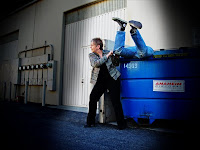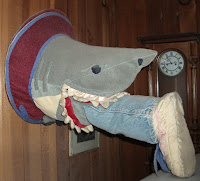-->
20 Things to kick-start creativity
This months blog project for the Etsymetal Team is to write about 20 things that we use to kick-start creativity. We all run into the wall from time to time. Here are twenty things we do to go over, under, around or through it.
1. Go to a museum.
For us, this is tantamount to sticking our fingers in a light socket. A museum, any museum, of any type be it art, historical, cultural, anthropological, natural history, you name it, will jump-start our batteries faster than almost anything.
2. Change scale/focus.
Go anywhere familiar, a park, neighborhood, shopping mall, ect. Now, look at it by taking in the really big picture, or conversely, look at it in minute detail.
3. Change context.
Go to a magazine stand and purchase 5 magazines that you would NEVER buy. Study them. This also works with TV Roulette. Watch a few shows that you would never watch. Keep your sketchbook in your lap
3. Word Up
Pick a word at random from a book or magazine. Research that word on the Internet. This can provoke themes or images.
4. Change cultures.
If you live near a metropolitan area, go to a market in an ethnic area. Pretend it is a big art supply store.
5. Turn your original idea or sketch upside down.
View it from a different perspective.
6. Restrict your choices.
For your next project, limit yourself to only materials that you have in your studio. A limitation in this sense spurs ideas in areas that you normally would have not considered.
7. Jump in the bushes.
Grab your digital camera and within a 1 mile radius of your studio, take photos – of local foliage (weeds, yard grasses), architecture, landscaping, construction, demolition and repair. When you view the images, look at them in terms of form, balance, texture and connection.
8. Maybe now is the time to explore Pasta.
Do your next project in a medium you’ve always wanted to work with but never got around to it. There’s always a learning curve with a new material. This will expand your expertise and give you a finished piece outside your usual scope of work.
9. Paper or Plastic?
Use construction paper and fit together a 3 dimensional model of a small focal item that can be incorporated into a piece of wearable art. Consider negative spaces, puzzle type fitting, perhaps cold joining as well as soldering. Then create this object in the medium of your choice, It could be metal, cast resin pieces, polymer clay, carved wood, etc.
10. Ask Mother Nature.
Get a handle on the use of color by studying nature. The Internet is your best source for photos. Google images gives an entire encyclopedia of examples of how nature uses color. Try photos of tropical fish to see how colors act when placed next to each other.
11. Google It!
Are you stuck for organic shape ideas? Use the Google images search to find photos of succulents, cacti, seed pods and other botanical examples. You’ll be amazed with what you find.
12. Play with your own poop.
Don’t throw away your mistakes. Keep them in a box for later inspiration. What didn’t work today could very well be the inspiration and a prominent element for a signature piece later on.
13. Clean up.
Clean your bench and sweep the studio floor. These are Zen like tasks and involve a certain amount of calm and concentration. Your mind will temporarily escape the frustration of creative block. Many times when doing this, we will find some material or half made piece tucked away on the bench that will inspire us to get rolling again. And even if you don't, you'll feel so good about a nice clean studio, you will be compelled to get back in there and make a mess.
14. Put those half-baked ideas back in the oven.
We have a box in our studio called “in progress.” These are not mistakes but rather projects that have not told us what they want to be when they grow up. Sometimes we revisit this box when creatively stumped. Often, these old projects get recombined or restarted with a new approach.
15. What would Da Vinci do?
We previously mentioned to go to a museum for inspiration. Many times when viewing paintings or sculpture, the artist depicts jewelry of the period on the subject. We study these examples of jewelry, how they’re worn and what they’re made of. You can really get inspired with some of the examples that you come across.
16. Go Japanese, or Sudanese, or Inuit or...
you get the idea.. Viewing examples of art from other cultures, ie pottery, textiles and adornment exposes you to a different aesthetic in form and balance. This departure may be just the thing to get you started again.
17. Go dumpster diving
America’s trash is an awe-inspiring cornucopia of creativity.
18. Walk backwards
Well, maybe not literally, but it works something like this. We all have familiar neighborhoods or “habitrails” that we walk through, usually in the same direction or pattern each time. Reverse the pattern. Walk the same path you always take, but in the opposite direction. You’ll see all kinds of things that you never saw before.
19. Gather a pile of your favorite things
You know, all those treasures that you have kept from different times of your life. These will be objects that have special meaning and memories for you. As you lay them out before you think about how you would express the meanings in your art.
20. You’ll notice that there is a method in the madness of creative stimulation. Many techniques are based on the concept of “pattern interrupt”. As we fall into repetitive patterns of behavior we tend to apply the same solutions over and over again. Putting yourself in an environment that interrupts your pattern of behavior or thinking will usually allow you to make new connections. So go ahead. Bungee jump off that bridge.









